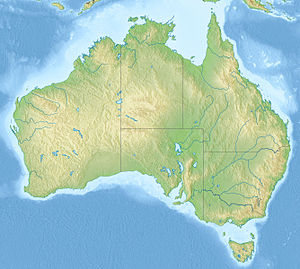Bass Street
| Bass Street | ||
|---|---|---|
| Satellite image of the Bass Strait showing the archipelago | ||
| Connects waters | Tasman Sea | |
| with water | Indian Ocean | |
| Separates land mass | Tasmania | |
| of land mass | Australian mainland | |
| Data | ||
| Geographical location | 39 ° 55 ′ S , 146 ° 7 ′ E | |
|
|
||
| length | 300 km | |
| Smallest width | 200 km | |
| Greatest depth | 50 m | |
| Coastal towns | Apollo Bay , Burnie , Devonport , Lorne | |
| Islands | King Island , Three Hummock Island , Hunter Island , Furneaux Group , Kent Group | |
| Historical map from 1846 | ||
The Bass Strait ( English Bass Strait ) is a strait that separates Tasmania from mainland Australia . It borders on the Australian side of the state of Victoria . It connects the Indian Ocean in the west with the Tasman Sea in the east. The first European to discover the strait was Matthew Flinders in 1798. Flinders named it after his ship's doctor , George Bass .
The strait is around 200 km wide at its narrowest point, and the average water depth is only around 50 m. Due to its shallow depth, it fell dry in the last Ice Age due to falling sea levels and formed a land bridge .
shipping
Like the other waters around Tasmania, it is particularly known for its shallow depth and for its rough seas. Many ships were lost here in the 19th century. A lighthouse was therefore built on Deal Island in 1848 to support the ships on the eastern part of the strait. On the west side there were no navigation aids until the completion of the Wilsons Promontory Lighthouse in 1859 and the construction of another lighthouse at Cape Wickham at the north end of King Island in 1861.
Strong currents between the Southern Ocean and the Tasman Sea make navigational conditions difficult. Hundreds of shipwrecks occurred on the Australian and Tasmanian coasts, as well as on the islands in the strait . Only stronger steel ships and modern navigation methods have significantly reduced the risk. Many ships, including some quite large, disappeared without a trace or left little remains. Despite myths and legends of pirates, wreckers and supernatural forces similar to those of the Bermuda Triangle , the disappearance of ships is more likely to be attributed to the treacherous combination of wind and current conditions and the numerous rocks and reefs , some of which are under water .
Islands
There are over 60 islands in Bass Strait. To the west, these include King Island , Three Hummock Island , Hunter Island, and Robbins Island . In the southeast of the strait is the Furneaux Group with over 50 islands, south of it the Waterhouse Island Group , in the northeast the Kent Group , the Hogan Group and the Curtis Group .
resources
There are oil and gas fields on Bass Street. The eastern field known as the Gippsland Basin was found in the 1960s and lies about 50 km off the coast of Gippsland . Oil and gas are transported via a pipeline to Longford , Western Port , Altona and Geelong for further processing , but also to New South Wales by tanker . The western field, known as the Otway Basin , was discovered offshore near Port Campbell in the 1990s and has also been exploited since 2005.
See also : Australian Worldwide Exploration (Australian company that operates oil and gas platforms)




